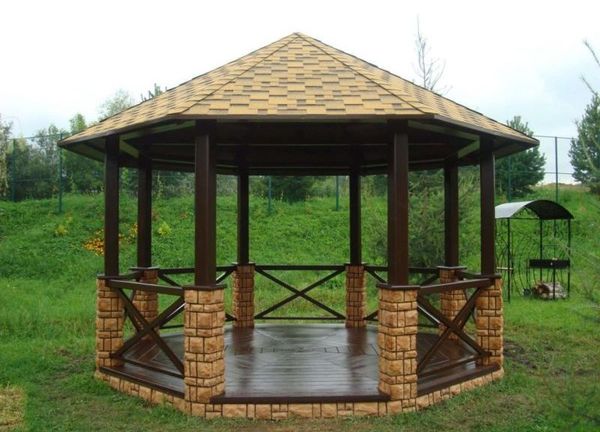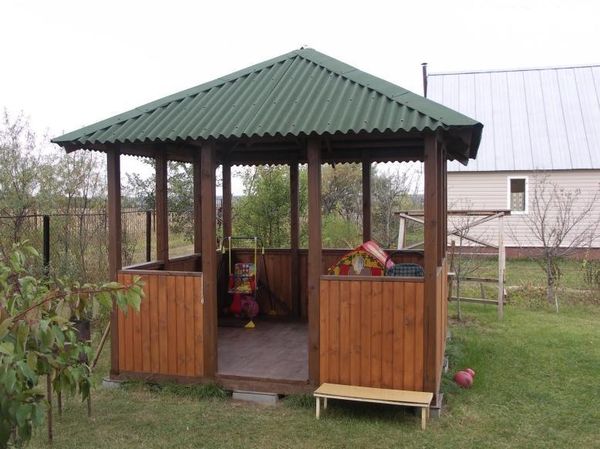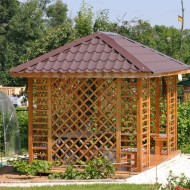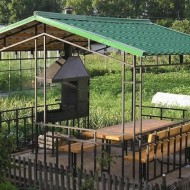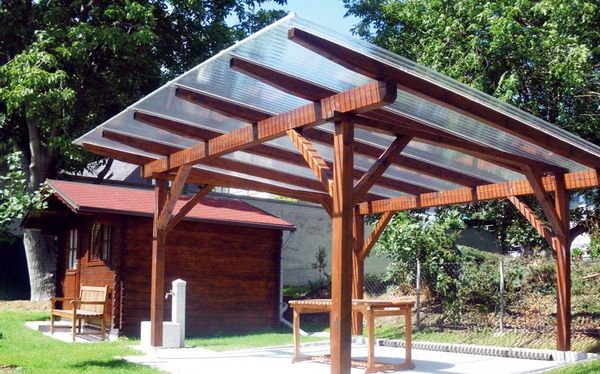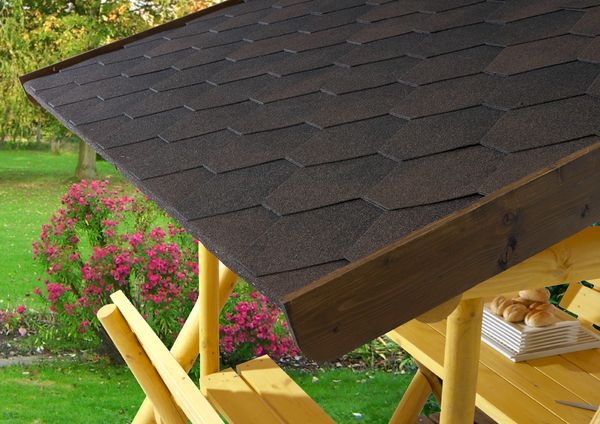Roof for the gazebo: general requirements and choice of materials
Content
Roof types and tips for beginners
This is one of the most important parts of a building to withstand wind loads. For this purpose, about 58% of summer residents prefer a pitched roof. The main elements here are the lathing and rafters. A variety of design options contributes to the solution of not only ordinary, but also complex design problems.
When choosing the optimal type of roof for a gazebo, the first thing to pay attention to is a shed structure. It provides reliable protection from precipitation and wind, and in conditions of a large slope area withstands 3-meter snowdrifts. Minimum costs for roofing materials and the ability to install without special equipment are among its other advantages.
The advantages of the gable version include:
- the presence of dense triangular surfaces that provide better protection of structures from rain and hail;
- the optimal angle of inclination contributes to high-quality drainage, and as a result - long-term use of slate and soft tiles;
- unlimited possibilities in the use of space under the roof;
- good maintainability;
- a wide range of roofing materials - from flexible covering to transparent polycarbonate.
A domed roof with a minimum weight is more durable than a gable roof. In the conditions of small-sized buildings, it can be made by hand in less than a day. For work, you need oak beams with a section of 100x50 mm, connectors, a profile pipe and a welding machine. Laying heavy slate, "live" canopy, and even more so a ceramic coating in this case is inappropriate. In order for a lightweight structure to last at least 20 years, it is better to cover it with a waterproof ondulin.
In gazebos with barbecues, it is acceptable to use fire-resistant structures with profiled sheets in the composition. The minimum snow load here often exceeds 150 kg per square meter. m roof.
Video "How to build a gazebo with your own hands"
From this video you will learn how to properly build a gazebo made of wood at a summer cottage.
Materials (edit)
A competent choice of coatings depends not so much on the price as on their resistance to mechanical stress. It is equally important to take into account the level of load on the supporting structures and the physicochemical properties of the products. First of all, we mean indicators of density, strength, hygroscopicity and, of course, fire resistance. For example, if they plan to build a gazebo with a barbecue in the country, the installation of a flammable roll roof is out of the question. Better to buy polycarbonate. The material is characterized by good flexibility, due to which strong arched structures are obtained. And besides, it does not support combustion.
Supporters of natural products can be advised by ceramic tiles. Most often it is laid on a wooden base. To prevent the roof from letting in water, it is important to ensure that the grooves are firmly fixed. If the shingles are placed incorrectly, the roofing cake will be filled with liquid after the first rain, and the snow retainers will completely cease to perform their functions.
Corrugated board
Profiled leaves with a thickness of at least 8 mm are the best option for arranging a round roof. The material lends itself well to processing, does not deform, and due to its light weight it contributes to safe installation at any height. In work, it is better to use products marked "НС", by means of which it is possible to close the ramp from the intersection of several planes to the cornice itself within 3-4 hours.
For overlapping colored sheets, you will definitely need self-tapping screws with rubber seals. The size of the fasteners depends on the height of the wavelike part of the sheet. Based on the roof area, you can determine their exact number.
Roof tiles and slate
The step-by-step installation of the bituminous shingles that are most in demand in our time looks like this:
- A tongue-and-groove board or plywood is placed on the prepared crate - this is the best basis for a flexible coating.
- A special underlay carpet is used as waterproofing. It can be attached to the base with construction glue.
- Lay down the start sheet.
- The upper and lower parts of the materials are stitched with nails.
If there is a long slope, installation work begins from the center point of the slope. The slate is laid from left to right, and nails are driven in at the highest point of the wave.
Polycarbonate
Polymer plastic roofing performs not only a protective, but also a decorative function. This is facilitated by the rich color range of products. The advantages of the material include light weight, easy installation, good light transmission and corrosion resistance.
Polycarbonate is one of the fragile products, so it is better to use professional tools in your work. For the device of a multifaceted roof, monolithic canvases with a thickness of at least 12 mm will be required. In the case of a pitched roof type - light rectangular honeycombs.
Self-tapping screws with sealing washers contribute to secure fixation of the panels.
Soft roof
The material provides one hundred percent protection from precipitation. This is facilitated by its structure: stone granulate, fiberglass, bitumen and protective film. Experts attribute a high level of sound insulation, the possibility of minor repairs and simple installation to other advantages of a soft roof.
Of the shortcomings, the first thing to mention is poor resistance to high temperatures and a low level of thermal insulation. For self-laying of a bitumen roll roof, you will need end strips, roofing nails, mastic, a hammer and sealant. In installation work, it is better to use sheets from several packages. So you can achieve uniformity of the shade within 8 or even 20 squares.
Other types
If it is important for the owners to emphasize a certain style of the exterior, it is more logical to choose other materials:
- Straw pre-treated with fire retardants. In this case, the thickness of the coating should not be less than 40 cm. For laying the coating, sharp games, wire loops and self-tapping screws are needed.
- Reeds that promote natural ventilation of the premises. In summer, such gazebos remain cool, and warm in winter. For the lathing device, screws are used, and it is better to fix the sheaves with wire.
- Wooden planks without connecting locks. They are laid with small gaps horizontally or vertically.
- Waterproof tarpaulins are attached with construction staples and nails.
- Sun protection membranes made of PVC components. They withstand temperature extremes well, reflect up to 65% of natural light and are non-flammable. Building glue can help to better seal the joints.
- Maintenance-free copper sheets. In order to avoid premature destruction of the metal, it is better to use galvanized fasteners.
How to make a roof
First you need to "put" the Mauerlat on the brackets. In wooden arbors, the function of this element is performed by a wreath made of timber. Then the rafters are attached to it, and the finished frame is attached to the building box.
To shorten the 5-meter span of the rafters, you need to install the racks, and then connect the supporting structure with the ridge girder. Metal plates will help with this.
Before making the lathing, you need to prepare a waterproofing layer from a waterproof membrane. Installation of a ventilation system is an equally important procedure. The viability of roofing materials depends on it.
After laying the covering, the roof should be insulated with mineral wool with a thickness of at least 180 mm.

